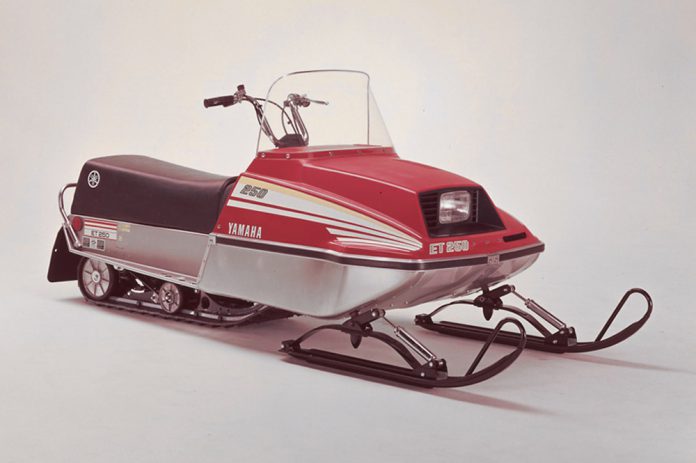I get a chuckle listening to committed vintage aficionados who, for the most part, were just a twinkle in their mom and dad’s eye when some of these classic sleds appeared on the landscape.
Since I’ve been around a while I can recount and document with firsthand experience how these vintage sleds impacted the snowmobile marketplace of the era. Of significant interest is the Yamaha Enticer series.
First arriving on the scene was the sled that changed the sport: the 1977 Yamaha Enticer 250. Many connoisseurs of all things Yamaha do not realize there was a very limited run of the original ET 250 for the 1977 model year.
It’s challenging to identify a real ’77 – here’s the simplest way to do it. The 1977 limited-build ET 250 did not have a dash mounted decompressor. Check out the decompressor toggle on a ’78 to fully visualize this descriptor of a 77.
Why is the ET 250 the “snowmobile that changed it all?”. When Yamaha first came to the market with the ET 250 the company literally shifted the paradigm that told the market what a snowmobile should be. Take oil injection. Yamaha arrived on the snowmobile landscape in the late 1960’s and every sled it sold was so equipped. Only racing destined rides like the original liquid cooled 440 SRX was premix. This feature alone caused this writer to hurry down to my local Yama-store and pick up a copy for the ridiculous sum of $1,249.00 Canadian. US ET 250s were $999.00 retail.
The ET 250 was light as a result of the liberal use of aluminum in the tunnel, body fenders and belly. The sled would pull heroic wheelies whenever you whacked the throttle and called up all 23 ponies. Sounds ridiculous doesn’t it? The 250cc single cylinder 2-stroke was a rumbler at idle but was smooth-as-silk once underway.
Its 28-inch ski-stance gave the sled a solid on-center feel and we (myself and a legion of friends who bought ‘78 ET 250s) could carve the twisties – outrunning sleds with way more HP. The ET 250 brought a new level of comfort to the sport. All Yamaha sleds at this time featured ultra-plush, foam seats covered with a grippy, stretchy cover.
Underneath the ET 250 was another game-changing feature – a molded rubber 15-inch-wide track with fiberglass rods imbedded in the carcass. These rods carried hardened steel clips for the slide rails to “slide” on.
The industry standard to this point were “built” tracks using three rubber belts (left, right and center) held together with riveted steel grauser bars. These built tracks were noisy, prone to grauser bar breakage and, unless studded, not particularly great at producing traction.
The ET 250 came with an unusual steel rail skidframe with a gas cell shock on the rear arm with torsion springs and an undamped torsion spring front arm. The skid looked odd but delivered a ride that flat-out drove around the skid’s used by Arctic and Polaris at the time.
Up front it was leaf springs but the front edge of these springs slid on friction eliminating UHMW blocks generating unheard-of leaf spring ride quality.
Here’s two important features of not just the ET 250 but every Yamaha sled of this era. Quality and reliability. The ET 250 was just about indestructible. Believe me, my friends and I tried to break an ET 250 with motocross antics and endless wheelies – but to no avail. That 250cc mill would pop to life on the coldest mornings and never, ever fouled a plug doing so. Even belt life was good despite a “secondary on tunnel chaincase” transmission design.
Another feature the competition had not brought to the market was matched-die fiberglass hoods. This process is similar to how Yamaha builds watercraft hulls. The bottom line is the inside of the hood was as smooth and warp-free as the outside. Competitive hoods continued to look like someone troweled wet kitty fur on their underside.
Yamaha brought so much that was new in MY 1978 the competition struggled to include the many value-added features on their comparable priced sleds. The ET 250 was the shot across the bow for the other players in the market. As a result they struggled until the end of the 70’s to match Yamaha’s Enticer series for value.
Arriving in rapid fire succession Yamaha upped the ante in the industry with the Enticer 340 twin and then the Enticer 300 twin. Both these sleds helped cement the reputation the ET 250 had established.
Stay tuned! There’s more to come on iconic Yamaha’s of the 70’s and early 80’s.



